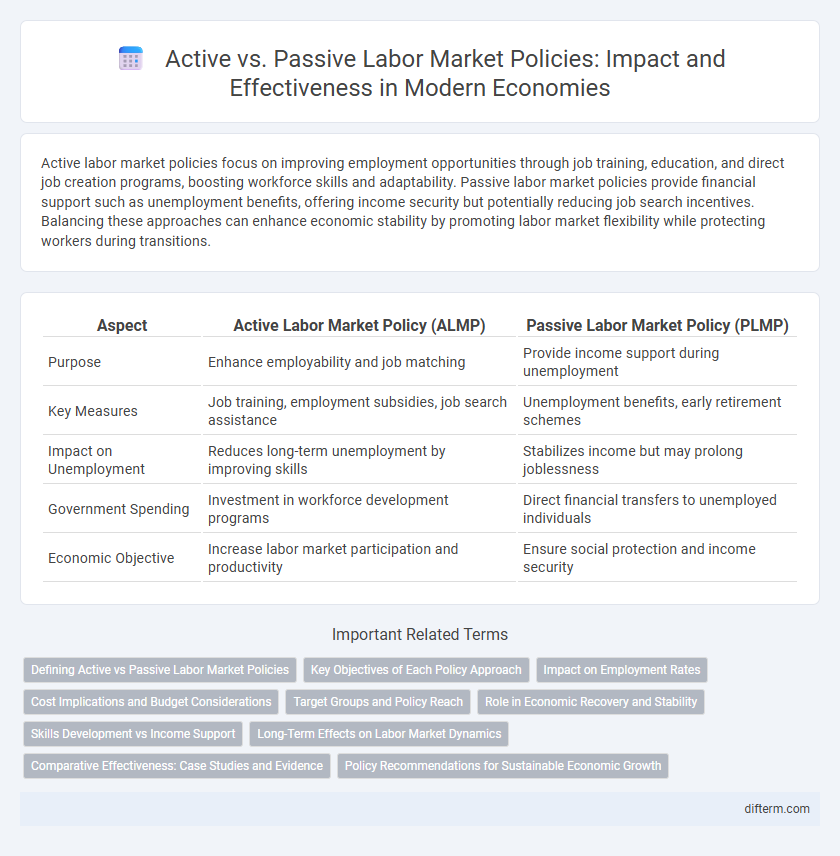Active labor market policies focus on improving employment opportunities through job training, education, and direct job creation programs, boosting workforce skills and adaptability. Passive labor market policies provide financial support such as unemployment benefits, offering income security but potentially reducing job search incentives. Balancing these approaches can enhance economic stability by promoting labor market flexibility while protecting workers during transitions.
Table of Comparison
| Aspect | Active Labor Market Policy (ALMP) | Passive Labor Market Policy (PLMP) |
|---|---|---|
| Purpose | Enhance employability and job matching | Provide income support during unemployment |
| Key Measures | Job training, employment subsidies, job search assistance | Unemployment benefits, early retirement schemes |
| Impact on Unemployment | Reduces long-term unemployment by improving skills | Stabilizes income but may prolong joblessness |
| Government Spending | Investment in workforce development programs | Direct financial transfers to unemployed individuals |
| Economic Objective | Increase labor market participation and productivity | Ensure social protection and income security |
Defining Active vs Passive Labor Market Policies
Active labor market policies (ALMPs) consist of government initiatives such as job training programs, employment subsidies, and job search assistance designed to enhance workers' skills and improve their employability. Passive labor market policies (PLMPs) primarily involve income support measures like unemployment benefits and social assistance aimed at providing financial security during periods of joblessness. The key distinction lies in ALMPs promoting workforce reintegration and skill development, while PLMPs focus on income replacement and social protection.
Key Objectives of Each Policy Approach
Active labor market policies (ALMPs) primarily aim to enhance employability by offering job training, skill development, and direct job search assistance. In contrast, passive labor market policies focus on income support through unemployment benefits and social assistance to stabilize household consumption during unemployment. Both approaches target labor market stability, but ALMPs emphasize reintegration into the workforce while passive policies prioritize financial security.
Impact on Employment Rates
Active labor market policies, such as job training programs and employment subsidies, directly enhance workers' skills and promote job matching, leading to higher employment rates and reduced unemployment duration. In contrast, passive labor market policies, including unemployment benefits and income support, primarily provide income replacement without actively facilitating job reentry, which may result in prolonged unemployment spells. Empirical studies consistently show that countries emphasizing active labor market interventions experience more significant improvements in employment rates compared to those relying mainly on passive measures.
Cost Implications and Budget Considerations
Active labor market policies, such as job training programs and employment subsidies, generally require higher upfront costs but aim to increase long-term employment and productivity, potentially reducing future welfare expenses. In contrast, passive labor market policies primarily involve direct income support through unemployment benefits, leading to ongoing budgetary pressures without necessarily improving job matching or workforce skills. Policymakers must balance immediate fiscal constraints against the potential economic benefits of investing in active measures that promote sustained labor market participation.
Target Groups and Policy Reach
Active labor market policies primarily target unemployed individuals, youth, and disadvantaged workers through training, job search assistance, and employment subsidies to improve their job prospects and labor market integration. Passive labor market policies focus on providing income support and unemployment benefits to a broader group of unemployed workers, ensuring financial stability during joblessness but without direct intervention for reemployment. The policy reach of active programs is narrower and more intensive, aiming at re-entry into employment, while passive policies cover a wider population with less direct impact on labor market outcomes.
Role in Economic Recovery and Stability
Active labor market policies, including job training programs and employment subsidies, directly enhance workforce skills and increase labor market participation, accelerating economic recovery by reducing unemployment duration. Passive labor market policies, such as unemployment benefits, provide income support that stabilizes consumer demand during downturns but may not significantly improve employment prospects. Effective economic recovery strategies integrate active measures to boost job creation with passive support to maintain aggregate demand and social stability.
Skills Development vs Income Support
Active labor market policies prioritize skills development through training programs, apprenticeships, and job search assistance to enhance worker employability and match labor market demands. Passive labor market policies focus on income support mechanisms such as unemployment benefits and social assistance to provide financial stability during joblessness. Investing in skill acquisition has proven to increase reemployment rates and long-term labor market participation more effectively than income support alone.
Long-Term Effects on Labor Market Dynamics
Active labor market policies (ALMPs), such as targeted training and job placement programs, enhance long-term labor market dynamics by increasing employability, reducing unemployment duration, and promoting workforce adaptability. Passive labor market policies, including unemployment benefits and income support, provide short-term financial stability but can inadvertently discourage job search efforts and prolong unemployment spells. Empirical studies show that ALMPs contribute to higher employment rates and productivity growth over time, whereas reliance on passive policies may lead to structural labor market rigidity and reduced economic growth.
Comparative Effectiveness: Case Studies and Evidence
Active labor market policies (ALMPs) such as training programs, job search assistance, and wage subsidies demonstrate higher effectiveness in reducing unemployment durations and improving employment quality compared to passive labor market policies like unemployment benefits and early retirement schemes. Case studies from Nordic countries reveal that ALMPs significantly increase reemployment rates, especially among long-term unemployed individuals, by enhancing skills and job matching efficiency. Empirical evidence consistently shows that investment in ALMPs yields better labor market integration and economic growth than reliance on passive measures.
Policy Recommendations for Sustainable Economic Growth
Active labor market policies, such as job training, wage subsidies, and employment services, enhance workforce adaptability and reduce unemployment duration, thereby fostering sustainable economic growth. In contrast, passive labor market policies like unemployment benefits provide short-term financial support but may inadvertently discourage rapid re-employment. Prioritizing investment in active measures, alongside tailored support systems, strengthens human capital and promotes long-term labor market resilience essential for stable economic development.
Active labor market policy vs passive labor market policy Infographic

 difterm.com
difterm.com